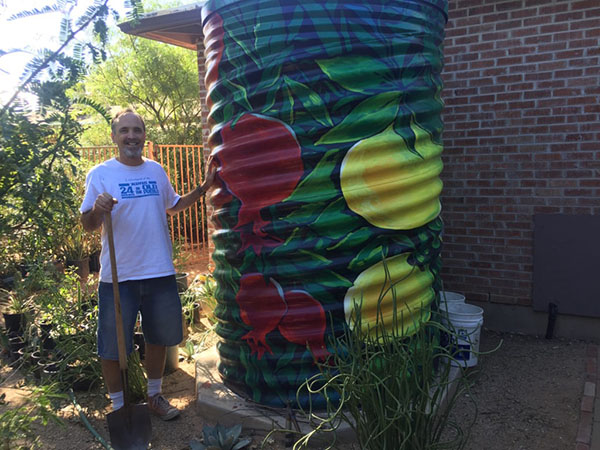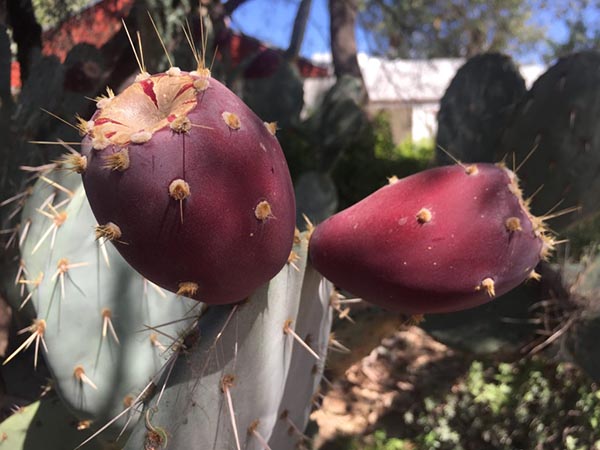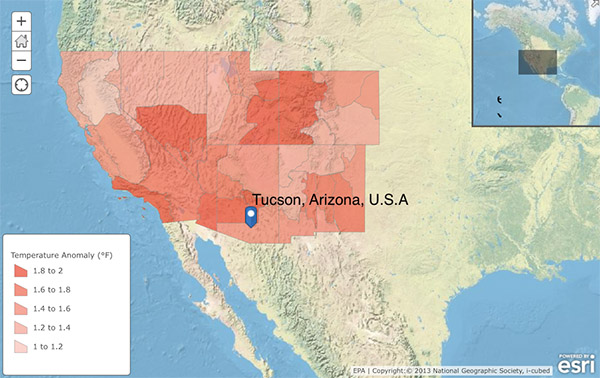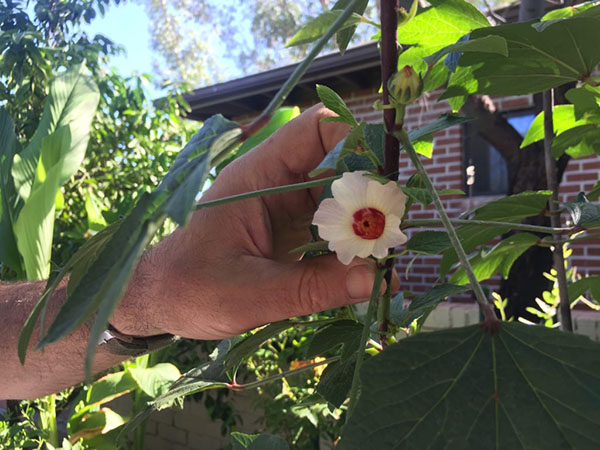Seventy-five year-old Mary-Jean climbs up on a short ladder to clear the fruit from her rain gutters. “The gutter likes grapefruit, and they like to plug the little hole where the water goes,” she explains, referring to the opening between the gutters and the downspout. The aluminum downspout drains the rainwater that falls on her roof into an 1100-gallon plastic cistern sitting in her backyard. She has two cisterns, and in early September they are halfway full, fed by the summer monsoon rains. Her yard is sparsely landscaped with reddish gravel and a handful of native trees and succulents. If she were not collecting the rain, she would be sweeping the gravel from the street back to the yard after every heavy rain. “It really slows down the water,” she tells me referring to the runoff and pointing to her front yard and steep driveway. The grapefruit tree came with the house, so she kept it. To water the thirsty tree, she connects a hose to the valve at the bottom of the cistern. The hose has little holes on the underside, so she can leave it running. “It works like a slow drip,” she explains. In front of her house there is a small sign made by the city that reads: “This house harvests the rain.”
A few years ago, the City of Tucson, Arizona launched a new rebate program to encourage rainwater harvesting at the residential level as part of its suite of water conservation initiatives. The program was a success in terms of implementation: Nearly 1300 households have installed rainwater cisterns through the program so far (and many more have done it independently). But a 2015 preliminary evaluation of water use data across households with harvesting infrastructure found that overall water consumption did not change upon installation. In fact, some households increased their water consumption. How is it that rapid diffusion of water conservation infrastructure was not accompanied by a decrease in potable water use as accounted by the water meter? This paradox is the starting point for an ongoing collaborative study on rainwater harvesting as well as a larger ethnography of water governance via infrastructural engagements in a desert city.

Mr. R. next to his rainwater cistern. All photos by the author.
There is a drip irrigation system in Linda’s house. This one is pretty much like Mary-Jean’s but this one is automated, much larger, and the water comes via the city, and not from the sky. Originally developed to improve water efficiency in the agriculture sector, drip systems are now the preferred method of residential irrigation in desert regions across the U.S. By distributing water slowly, they let it seep towards the plants’ roots before it evaporates or runs off. Linda is also doing rainwater harvesting. She installed four tanks when she moved into this house from the East Coast, as part of her landscaping vision for her new home. She wanted a desert-oasis with drought-resistant shrubs and vines that would attract pollinators. “The idea was not to water them once they were established,” she explains looking at the bird of paradise outside the window by her swimming pool. But three years after planting, they are still watered with the drip-irrigation system automatically delivering a blend of Colorado River water and groundwater every other day for 45 minutes.
Roberta does not have a drip system, or any form of automated irrigation for that matter. She has been harvesting rainwater since she can remember and recently replaced her array of buckets with a 1300-gallon plastic tank. Originally from northern Mexico, she has been living in Tucson for nearly thirty years. She has a small yard. Fruit-bearing trees and bushes are the only vegetation present. And she has quite a few of them: native prickly pears and chiltepines, heritage varieties of quince and pomegranate, and a couple of thirsty citrus trees. To water them she now relies exclusively on rainwater. “The vegetation is more lush, and I think I may even have more fruit,” she observes as we stand under the trees. It is 103 °F out. The shade is a relief.

Prickly pear fruit almost ready to pick
***
The prolonged drought affecting the U.S. Southwest since the turn of the century, the maybe more emblematic recent California drought, and regional climate change projections underscore the imperative for cities and urban residents to develop innovative forms of water governance. Rainwater harvesting is on the rise as a form of green infrastructure in cities across the region, often heralded as a strategy for climate change adaptation. This term encompasses everything from large cisterns that collect rainwater from roofs to earthworks like berms and basins that redirect storm runoff and capture water onsite. Both active and passive forms of water harvesting are off-the-grid forms of infrastructure that allow urban residents to collect, divert, and sometimes store water for later use, mainly for landscape irrigation in homes and adjacent right-of-ways. The crescendo of rainwater harvesting infrastructure is a revival of low-tech water management practices turned innovative by their contrast with large-scale gray infrastructure. Only a decade ago rainwater harvesting was simply overlooked or discarded by municipal authorities as a “hippie” idea. Today it is increasingly encouraged via rebate programs and gradually regulated through city ordinances and design guidelines principally under a water conservation framework. In other words, this grassroots decentralized infrastructure is becoming an object of water governance in a region faced by a double exposure to climate change and urban growth.
The city of Tucson – with its half a million residents – has three water sources: Colorado River water pumped through the 336-mile long Central Arizona Project (CAP), groundwater from the underlying aquifer, and minimal effluent water. In water management parlance these constitute the city’s water budget. Located in the Sonoran Desert, the city receives on average 11.6 inches of rain a year. About half of it comes down during the spectacularly beautiful summer monsoon thunderstorms, and the other half with the calmer winter rains. For urban residents this precipitation pattern means that rain is often scarce when the water requirements of their landscape vegetation seem to be the highest as temperatures reach the triple digits in the early summer. I am talking about 115°F, here. Generally, outdoor irrigation makes up about thirty percent of residential water consumption in single family homes, and this number peaks in the summer. For that reason, it should be no surprise that promotion of rainwater harvesting infrastructure is normally framed in policy materials as a strategy for reducing potable water consumption by providing a “new water source” for irrigation. Linda, Mary-Jean, and Roberta all described rainwater harvesting as a source of guilt-free water for irrigation.

Average temperatures in the Southwestern United States, 2000—2015 versus long-term average. Data source: NOAA, 2016
Our initial research question was straightforward, and fairly easy to answer with interviews, household landscape surveys, and monthly self-reports on water usage. Why has there not been an immediate and positive correlation between rainwater harvesting and water conservation? Linda’s water consumption increased significantly because she had her cisterns installed at the same time as she had numerous shrubs and succulents planted in her yard. These plants need watering to get established, even though they are drought-resistant. They are connected to an irrigation system that is managed by a landscaping company; Linda has little understanding of plant requirements or irrigation. There were many residents in similar situation as Linda. By comparison, Roberta’s water use did not change significantly, and Mary-Jean’s slightly decreased. None of them had added much new vegetation and are replacing tap water with rainwater for irrigating their thirsty trees when possible. Their rainwater storage capacity is the same, but Roberta has more trees. Mary-Jean’s water consumption trend especially stood out. She was consuming less than 2 CCFs, and any decrease at that level is almost imperceptible. A CCF or a hundred cubic feet is equivalent to 748 gallons. The meter doesn’t count subtlety, I was told. But the changes to her household did not seem subtle.
As I peered over neat bar graphs showing how many CCFs each household had consumed each month over the last three years, the work of Alex Loftus came to mind. In pursuing our research question, I wondered, was I expanding the conquest of decentralized and grassroots green infrastructure by what he calls the dictatorial water meter? Was this an example of formal rationality where the socio-ecological processes unfolding in peoples’ backyards and neighborhood streets were flattened and reduced to calculability and bureaucratic administration via the water meter? My research collaborators –who are themselves dedicated to water conservation education and policy– agreed with the need to look beyond the meter and draw from the experiences of these households to characterize how residents understood rainwater harvesting and how they valued its impacts. Thus, we are integrating landscape mapping with cognitive mapping to document how rainwater harvesters understand rainwater collection and its impacts. In other words, are the impacts that residents experience through installing and managing this infrastructure the same as the benefits anticipated by policymakers? There are a growing number of practitioners working to find ways to account for those diverse benefits.

Hibiscus flower
***
Yes, rainwater cisterns are relatively simple technological objects, but they come attached to substantial socio-political questions. For example, is the formalization of decentralized water infrastructure redefining urban citizenship? Can this technology be mobilized to reduce structural vulnerability to climate change? We have so much to learn about otherwise mundane infrastructural systems, the everyday socio-ecological relations that constitute them, and the incentives and constraints for their adoption across diverse populations. Thus, this study begets ethnographic explorations into people’s backyards, plant nurseries, and irrigation classes, as well as historical analysis of regional water law and policy. Owing to the 1902 Reclamation Act, the 1922 cornerstone Law of the River, and the 336-miles long CAP, Roberta’s fruit trees and Linda’s swimming pool are intimately connected to the Colorado River, to California, and their struggles with climate change. We may not be part of the same watershed, but infrastructure made as part of the same waterscape.
